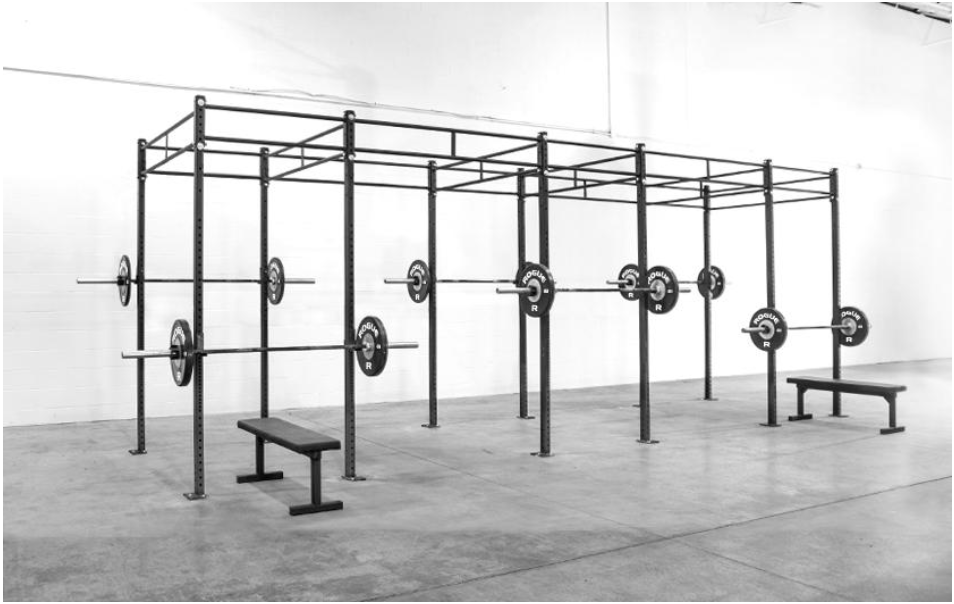Power rack: What to do
A squat rack can be used for many different exercises and in this article you will find some options. You will also learn how to set the exercises up in a safe way for yourself.
Related articles
Exercises you use the rack for
Attached you find a list of the exercises for which a squat rack or power rack are commonly used for:
The barbell back or front squat are common exercises to be done in the squat rack. For these adjust the J cups at a height that enables you to pop the bar out by straightening your hips. There should be no driving of the feet into the ground or activation of your quads necessary to achieve this. The safeties should be set up just below the lowest point you can squat to. In case of a failure you want to lower the weight controlled to this height and then carefully dump the weight onto the safety.
The most common bench press variations are the incline, decline, and flat bench press. For the incline and decline I would personally recommend a spotter over safety pins. For the flat bench press set the safety up an inch below your arch. To learn more about how to arch for the bench press read how to bench press like a powerlifter. In case you fail a rep slowly lower the bar to your chest. Exit the arch slowly while the bar rests on your chest. This way it will ease its way into the safety and you can exit beneath.
For the rack pull, you will adjust the safety somewhere between ankle and slightly above the knee height. This will the starting position. The higher up from the ground you are, the more you can pull as the range of motion is shorter. Rack pulls are a variation on the deadlift to use more weight for repetitions to train the lower back harder. I am personally not a great fan of rack pulls as they bear an unnecessarily high injury risk. Stiff legged or Romanian deadlifts achieve similar results while exposing your back to a lower risk.
Pin squats or a variation of the back squat to generate more power out of the hole. You want to adjust the pins to a height that is just an inch above the lowest position you can squat to. Lower the bar to the pin and lose all momentum and bounce while still keeping tight. From there initiate the drive up. This is a great accessory movement to develop strength in some of the weakest parts of the squat. Pins are usually preferred over safety straps for this exercise.
Even though it is surprising, use the squat rack for deadlifts and avoid using the space in front of the rack for it. You can also use a deadlift platform or open space for the deadlift just avoid the area right in front of the rack. Using the area in front of the rack will block access to it for others and more often than not ends up in a walking path of other gym members. If you deadlift in the rack, the rack is still blocked, but at least people can freely move around it.
If you want to do the overhead press or military press do it at the outer space of the rack. Inside the rack you are very likely to bounce off the rack structure when you push. Adjust the height of the J cups just at the chest while standing. Leave them at a height you can conveniently dump the bar into the cups without having to get on your toes bending your knees to get to a lower position.
Exercises you don't use the squat rack for
These are exercises which I would not recommend to use the squat rack for. Especially when the gym is busy.
Bicep curls don’t need a rack and can be done outside it even if you are using the barbell. Use the dumbbell area and preacher curl station to get your bicep work in.
The Olympic lifts like the snatch and clean jerk are best done from the ground on a Olympic weightlifting platform or padded area of the gym. Make sure you have space around you to drop the bar if you were to lose control.
Common mistakes when using a squat rack
-
Setup too high
-
Setup too low
-
Walking out forwards
-
Not setting up safeties
The bar is setup up too high when you can barely unrack the bar and only have a thin piece of air between the bar and J cups when you unrack the bar. In this case you can not dump the bar when you get in trouble as you usually lose a few inches on posture. If there is this little space the bar is too high, so go one step down.
The opposite off too high is too low. If you have to heavily engage the targeted muscle groups just to get the bar say from the rack, your setup is too low. the relevant joint should only be straightening a little from an almost extended position.
Waking out forwards away from the J cups is generally not a good idea. This will put your setup into a blind spot when you want to rerack the bar. If you have to reverse into a blind spot when you are already in trouble with your lift you won’t like it. Keep your eyes in front and start the movement by walking out backwards.
The last point is to set up the safeties for your specific height and exercise. It only takes a minute and can save you a world of pain in case something goes wrong.
Safety options
There are three main safety options for a power rack:
Safety pins are the most common and are available in almost every gym. They are cheap and stable. They are also great for pin squats when you have problems getting out of the hole. The negatives of safety pins are that they can be annoying to set up. Fiddling the steel rod into the hole of the rack can be time-consuming. More often than not you will not set it up parallel to the ground but with a tilt. Another disadvantage is the bounce. Pins deform and bounce the bar back up. This not what you want on a heavy drop.
Safety straps are one step up from safety pins. You don't see them as often as safety pins in regular gyms. The two big advantages are that they are easier to set up and have a dead stop when you drop the bar. No bouncing around The disadvantage is that they are harder to set up at the right height and therefore also not as good for pin squat.
The rolls Royce of safeties is the flip-down. The flip-down safety is usually hooked into the rack and has a wider space where you can drop the bar to. And can be used for pin squats and rack pulls with more ease and less noise. To some, you can even attach a seat for box squats.
Power rack: what to do
Know the right setup for the K cups and safeties for your height and exercises. Practice to fail with sub maximum load a couple of times. Take note of the slots you use until it becomes second nature. When you enter a new gym be conservative and get used to the new equipment before pushing your limits.


